Invented by Michael J. Faulks, Robert Lee Popp, Michael D. Sperl, Nancy Meetz, Sandra M. Rogers, Lorelle M. Scheibe, Joseph P. Fell, Christine Ann Caneba, Kimberly Clark Worldwide Inc
First, let’s define what we mean by personal wear absorbent articles with disposal tabs. These products typically include items such as adult diapers, menstrual pads, and incontinence pads. They are designed to be worn directly against the skin and are made from absorbent materials that can hold large amounts of liquid. The disposal tabs are a key feature that allows users to easily and discreetly dispose of the used product without having to touch it directly.
One of the main drivers of the market for personal wear absorbent articles with disposal tabs is the aging population. As people get older, they are more likely to experience incontinence or other issues that require the use of these products. Additionally, there is a growing awareness of the importance of hygiene and cleanliness, which has led to increased demand for products that offer these benefits.
Another factor driving the market is the rise of e-commerce. Many consumers prefer to purchase these products online, as it allows them to shop discreetly and conveniently from the comfort of their own homes. This has led to the emergence of a number of online retailers specializing in personal wear absorbent articles with disposal tabs.
In terms of key players in the market, there are several major companies that dominate the industry. These include Kimberly-Clark, Procter & Gamble, and SCA. These companies have significant resources and expertise in the development and marketing of personal care products, which gives them a competitive advantage in the market.
However, there are also a number of smaller players in the market that are gaining traction. These companies often focus on niche products or target specific demographics, such as eco-conscious consumers or those with sensitive skin. This has led to a proliferation of new products and innovations in the industry.
One of the biggest challenges facing the market for personal wear absorbent articles with disposal tabs is the stigma surrounding these products. Many people are uncomfortable discussing issues related to bodily fluids, which can make it difficult to market these products effectively. Additionally, there is a perception that these products are only for the elderly or infirm, which can limit their appeal to younger consumers.
Despite these challenges, the market for personal wear absorbent articles with disposal tabs is expected to continue growing in the coming years. As the population ages and awareness of hygiene and cleanliness increases, demand for these products is likely to remain strong. Additionally, the rise of e-commerce and the emergence of new players in the market are likely to drive innovation and competition, which will benefit consumers.
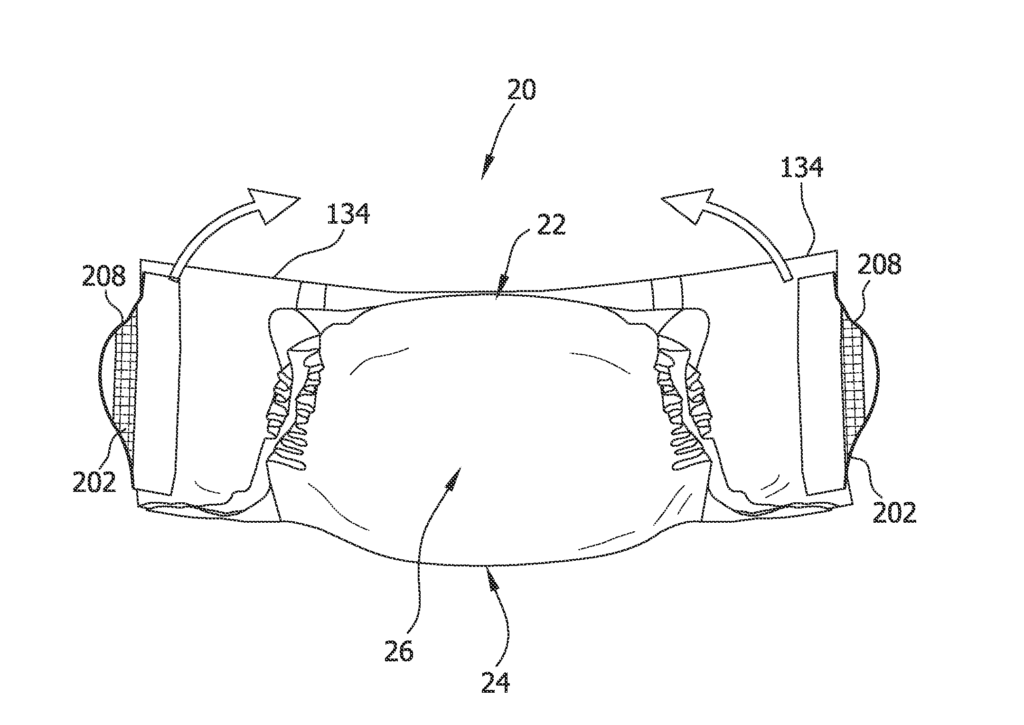
The Kimberly Clark Worldwide Inc invention works as follows
An absorbent article has a front waist, back waist and crotch regions. An article fastening system attaches the front and back waist regions to one another to create a wear configuration for the absorbent article. The article can be configured from a wear configuration to a disposal arrangement. The disposal tab is attached to one side of the article by an attachment region. It extends a maximum length La along at most a portion Lp of one side. The tab region is transversely extended from the attachment area a maximum distance Dt. It attaches to the article in the minimum disposal configuration. An attachment region includes a first surface that attaches to one side of the article, and a second surface that forms part of the article fastening mechanism.
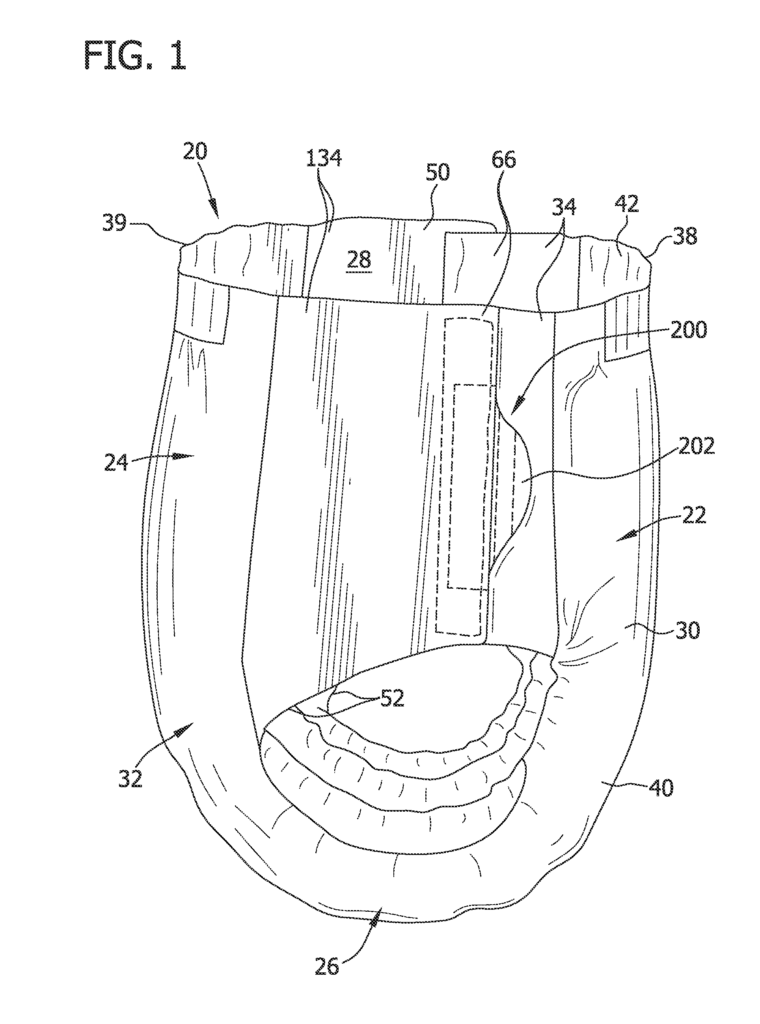
Background for Personal wear absorbent article with disposal tab
The invention generally relates to absorbent articles for personal use, but more specifically to disposable absorbent items.
Many absorbent articles are intended for personal use, e.g. diapers, training pants and feminine hygiene products. They can also be used as bandages, bandages, medical clothes, and other garments. To reduce irritation from prolonged wetness, the garment should be kept away from the wearer. For example, diapers are placed on the wearer with a set or primary fastening tabs. These can be adhesive tabs or mechanical (e.g. hook or loop), fastening system tabs. They are left in place to absorb insults and contain fecal matter. The caregiver may fold the diaper into a smaller size and then secure it using the primary fastening tabs.
Training pants are typically pre-assembled in a fashion that is more similar to conventional underpants than diapers. To define a wear configuration for pants with a waist opening or leg openings, the front and back waist regions are usually attached permanently to training pants.
Pop-opens (separation) of fasteners can occur in articles that are refastenable such as diapers or training pants. This is due to the stresses placed on the attachment from movement. When a refastenable design is used for training pants, the pants can be taken off without being unfastened. This will also leave no fasteners to keep the pants compacted for disposal. The fastening parts are invisible when the pants are on, so the consumer is not aware of their refastenability. For such training pants, a permanent attachment may not be used. There is no fastening system available to keep the pants in a compact configuration.
The fastening tabs on diapers are very small in the longitudinal direction. They are usually longer in the transverse directions, as they are used to wrap the diaper around the wearer and secure the diaper to the front. Because the sides of a diaper are very short (e.g. from the waist opening to the leg opening), it is easy to control the sides with the small fastening tabs on diapers. Training pants’ sides are generally longer than diapers’ and can be difficult to control with a tab that is as small as the one on diapers.
There is a need for a disposal system for an absorbent article like training pants. This will provide improved resistance to pop-opens and secure the article in a compact configuration. It will also allow the consumer to be aware of the existence of such a fastening device and enable them to use it.
An absorbent article for personal use around a wearer’s waist typically comprises a liquid permeable outer surface for facing the wearer and an inner surface for facing away. The absorbent body is disposed between the two. The front and back waist regions can be permanently and releasably attached to each other using an article fastening device to create a wear configuration. This absorbent article has a waist opening and two leg openings that are spaced apart from the waist opening. Each side extends a length of Lp from one of the leg openings to the waist opening. The article can be configured from a wear configuration to a disposal arrangement in which the article has been generally compacted for disposal. The disposal tab is attached to one side of the article. It has an attachment area that extends at least a portion the length of one of its sides. The tab region extends transversely from the attachment area a maximum distance Dt. It is attachable to an article in the minimum disposal configuration. There is a first and second surface to the attachment region of the tab. The article’s first surface attaches to one side. The disposal tab’s second surface is attached to one side of the article. It forms part of the article fastening mechanism.
Another embodiment of an absorbent article for personal use around a wearer?s waist comprises a liquid permeable outer surface for facing the wearer and an inner surface for facing away. An absorbent body is disposed between the two. A front waist region, back waist region, and crotch regions are interconnected longitudinally between the front and rear waist regions. The front and back waist regions can be permanently attached to each other using an article fastening device to create a wear configuration. This absorbent article has a waist opening and two leg openings that are spaced apart from the waist opening. Each side extends a length of Lp from one of the leg openings to the waist opening. The article can be configured from a wear configuration to a disposal arrangement in which the article has been generally compacted for disposal. The disposal tab is an attachment area attached to the article’s side. It has a longest length La that extends longitudinally. The tab region extends transversely from the attachment area a greatest distance Dt. It is attachable to an article in the least disposal configuration. Dt is approximately 10 to 20 percent of the longest length La. The longest length Lt that extends longitudinally from the article’s tab region is about 10 percent to 20 percent. There is a first and second surface to the attachment area of the disposal tab. The article’s first surface attaches to one side. The disposal tab’s second surface is attached to one side of the article. It forms part of the article fastening mechanism.
Another embodiment of an absorbent article for personal use around a wearer’s waist comprises a liquid permeable outer surface for facing the wearer and an inner surface for facing away. An absorbent body is disposed between the two. The front and back waist regions can be permanently attached to each other using an article fastening device to create a wear configuration. This absorbent article has a waist opening and two leg openings that are spaced apart from the waist opening. Each side extends a length of Lp from one of the leg openings to the waist opening. The article can be configured from a wear configuration to a disposal arrangement in which the article has been generally compacted for disposal. The disposal tab is an attachment area attached to the article’s side. It has a longest length La that extends longitudinally. The tab region extends transversely from the attachment area a greatest distance Dt. It is attachable to an article in the least disposal configuration. The tab attachment region has a length of La that is significantly longer than Dt. Dt ranges from approximately 5 mm to around 20 mm. The longest length of the tab region is Lt, which extends longitudinally. There is a first and second surface to the attachment area of the disposal tab. The article’s first surface attaches to one side. The disposal tab’s second surface is attached to one side of the article. It forms part of the article fastening mechanism.
Other features” of the invention will be partly apparent and partially pointed out in this document.
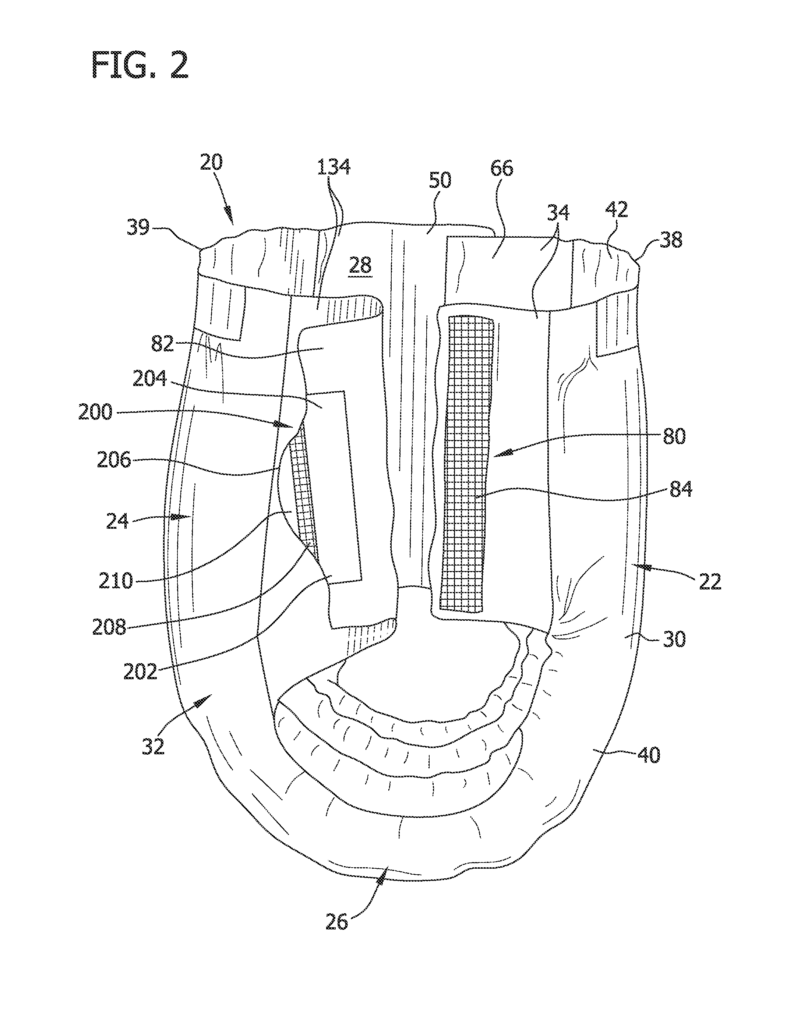
Referring to the drawings, and in particular FIG. 1. A personal wear absorbent article according one embodiment is illustrated as a pants-type article to wear around the waist of the wearer, more specifically in the form children’s toilet training trousers, which are indicated by the reference number 20. Absorbent articles are generally placed on or near the body of the wearer in order to absorb and/or retain liquid wastes. Articles that are disposable may be used to refer to articles that can be thrown away after a short period of time, rather than being washed or restored for another use. The concepts described herein can be used with other pants-type articles like adult incontinence articles and other articles for personal use such as clothing, diapers and feminine hygiene products, medical articles, surgical pads, bandages and other personal care or healthcare garments.
By way only of illustration, different materials and methods for building the training pants 20 are disclosed by PCT Patent Application (WO 00/37009), published Jun. 29, 2000 by A. Fletcher et al; U.S. Pat. No. 4,940,464 July. 10, 1990 to Van Gompel and al. 10, 1990 to Van Gompel et al. No. No. 5,766,389 issued June. 16, 1998 to Brandon and al.
FIG. 20 shows the pair of training pants 20. FIG. 1 shows the pair of training pants 20 in fully assembled (i.e. as it was during initial manufacture) condition. FIG. 2 shows the pants in wear configuration, which is also known as an absorbent article. FIG. 2 in partially unfastened conditions. The training pants 20 have a front waist area 22 and a back waist region 24. A crotch 26 extends longitudinally between the front and back waist regions. An inner surface 28 is designed for contiguous relation with the wearer. The outer surface 30 is opposite. Refer to FIGS. 3. and 4. The training pants 20 have a pair each of 36 and 39 laterally opposite side edges. A pair of longitudinally opposed waist edges are also included, which are designated respectively as the front waist edge 38 or back waist edge 39. The front waist area 22 is adjacent to the front edge 38 and the back waist is contiguous to the back edge 39.
The illustrated pants 20 include a central absorbent assembly (generally indicated at 32), which is laid flat as shown in FIGS. The shape of 3 and 4 may be any type you desire. The absorbent assembly 32 at front waist area 22 is flanked by a pair of laterally opposing front side panels 34. This forms transversely outside portions of the front waist and, more generally, the transversely opposite sides to the training pants. The 134 laterally opposite rear side panels extend outwards from the absorbent 32 at the back region 24 (thereby creating transversely outer portions and more broadly defining the sides the training pants).
The central absorbent assembly 32 in the illustrated embodiment consists of an outer cover 40 (FIGS.) and a bodyside liners 42 (FIGS. 1, and 2, are connected to the outer covering in a superposed relationship by suitable means, such as adhesives or thermal bonds, or other conventional methods. An absorbent structure 44 (FIG. Between the outer cover, the bodyside liner and the absorbent structure 44 (FIG.4) Two containment flaps 46 are shown in FIG. For preventing the lateral flow exudates, a pair of containment flaps 46 (FIG. The opposite ends of the central absorbent assembly 32 form portions of the front, back and waist edges 38 and 39 respectively. 47 on the other hand form portions the sides 36 and 37 of the training pants 20 (FIGS. 3, and 4).
The absorbent assembly 32, 34, and side panels 34,134 can be composed of two or more elements, as shown in FIGS. They may be either integrally formed or two separate elements. The 34, 134, 32 absorbent assemblies and the side panels that are integrally formed would contain at least some common materials such as the flap composite, bodyside liner, outer cover and/or other covers. This could be used to create one-piece elastic, stretchable or nonstretchable pants 20. Further reference is provided by the arrows 48-49 in FIGS. The orientations of the longitudinal axis of the training pants 20 and the transverse or lateral of the training pants 20 are shown in FIGS. 3 and 4.
With the training pant 20 in the fastened condition, as illustrated in FIG. 1. and FIG. 2 The front and back sides 34, 134 are connected to one another by a primary, also known as an article fastening system 80. This allows for the three-dimensional pre-assembled wear configuration of the pants. They have a waist opening of 50 and a pair 52 of leg openings. The portion of training pants 20 that is worn at least partially on the front is the front waist area 22. The back waist region 24, on the other hand, is the portion of training pants 20 that is worn at least partially on the back. The portion of the training pant 20 that is between the legs and covers the lower part of the wearer’s torso is the crotch area 26.
The front and back sides panels 34 and 134 are the portions of the training pant 20 (and in particular the front and rear waist regions 22, 24, respectively) that, when worn, are placed on the wearer’s hips. Attached side panels 34 and 134 define the transversely opposing sides of the pants 20. Each side extends a length Lp. (FIG. 5) between the waist opening 50 and the respective leg opening 52 at an Engagement seam 66, along which the fastening 80 attaches the back and front side panels. The waist edges 38 of the training pants 20 and 39 of the trousers 20 are designed to wrap around the waist and define the 50-inch opening (FIG. 1). The leg openings 52 are generally defined by the portions of the 36-inch side edges in the crotch area 26.
The central absorbent assembly 32 is designed to absorb and contain exudates that are discharged from the wearer. The 46 containment flaps are designed to prevent the transverse flow exudates. FIG. 53 shows a flap elastic member 53. A flap elastic member 53 (FIG. To seal the body, the elasticized containment flaps 46 have a partially unattached edge that assumes an upright position in the crotch 26 of the training pants 20. The containment flaps 46 are located along the 36-inch side edges of the pants 20. They can be found along the absorbent 32’s length or only partially. The suitable constructions and arrangements of the containment flaps 46 can be found in U.S. Pat. No. No.
The training pants 20 include a 54-inch front waist elastic member (FIG. 4), a rear elastic member 56, and leg elastic parts 58. These are all known to those who are skilled in the art. The waist elastic members 54, 56 and 42 can be attached to either the outer cover 40 or the bodysideliner 42 at the opposite waistlines 38 and 39. They can extend over a portion or all of their waist edges. Leg elastic members 58 can attach to the outer cover 40 or 42 along the opposite side edge 36. They can then be positioned in the crotch area 26 of the training pant 20. Leg elastic members 58 can also be placed longitudinally along the side edges 47 and 32 of the absorbent system 32.
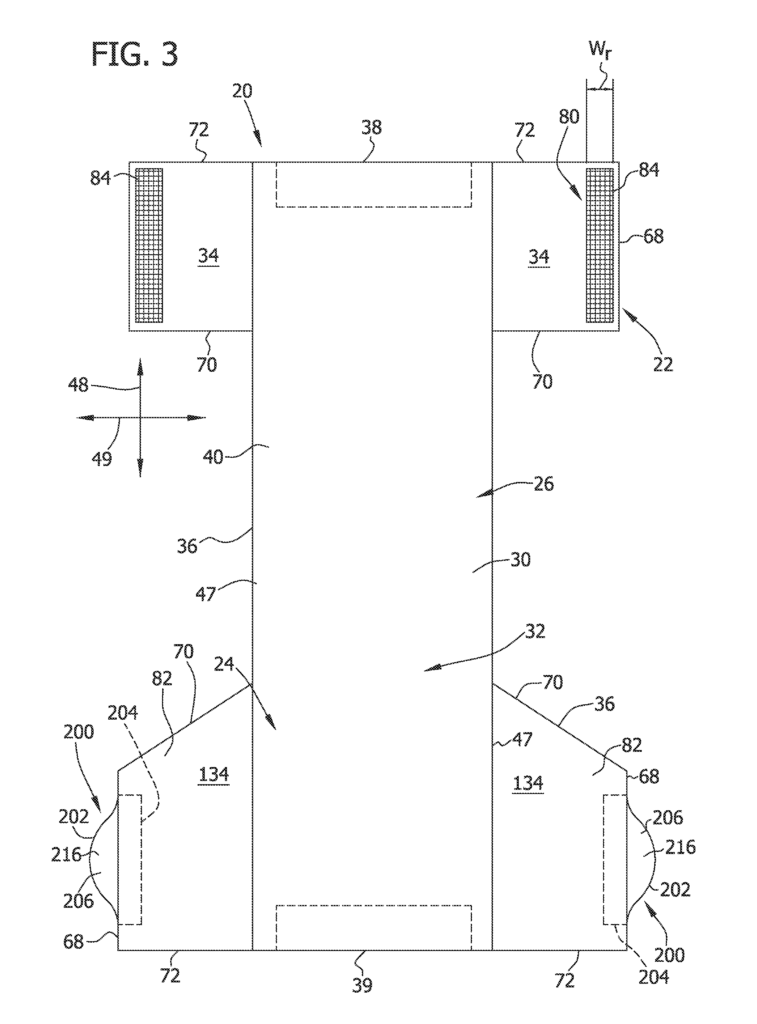
The flap elastic members 53, 56 and 54, respectively, as well as the leg elastic members, 58, can all be made of any elastic material. The art of making elastic materials is not difficult. They can be sheets, strands, ribbons, or ribbons made from natural rubber, synthetic rubber, and thermoplastic elastomeric plastic polymers. You can stretch the elastic materials and stick them to a substrate. Or you can adhere them to a gathered substrate. The substrate can then be elasticized or shrinkage, for example by applying heat to create elastic retractive forces to the substrate. One embodiment of the leg elastic members 58 includes a number of dry-spun, coalesced, multifilament spandex elastomeric yarns that are available from E.I. Du Pont de Nemours and Company Wilmington, Del., U.S.A.
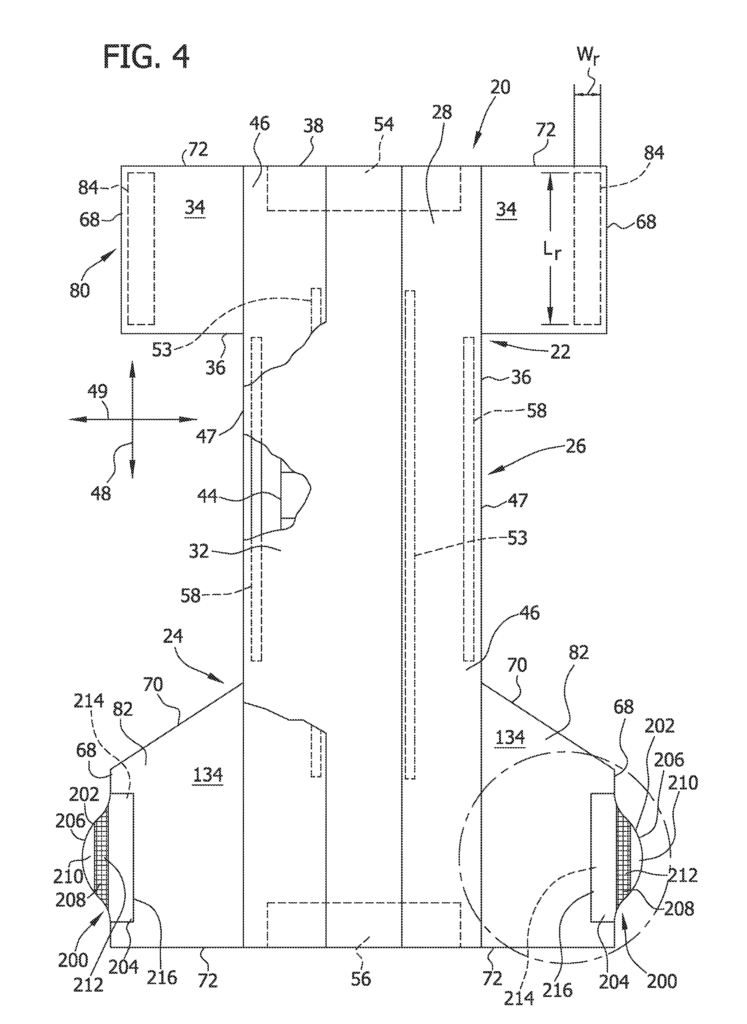
Click here to view the patent on Google Patents.
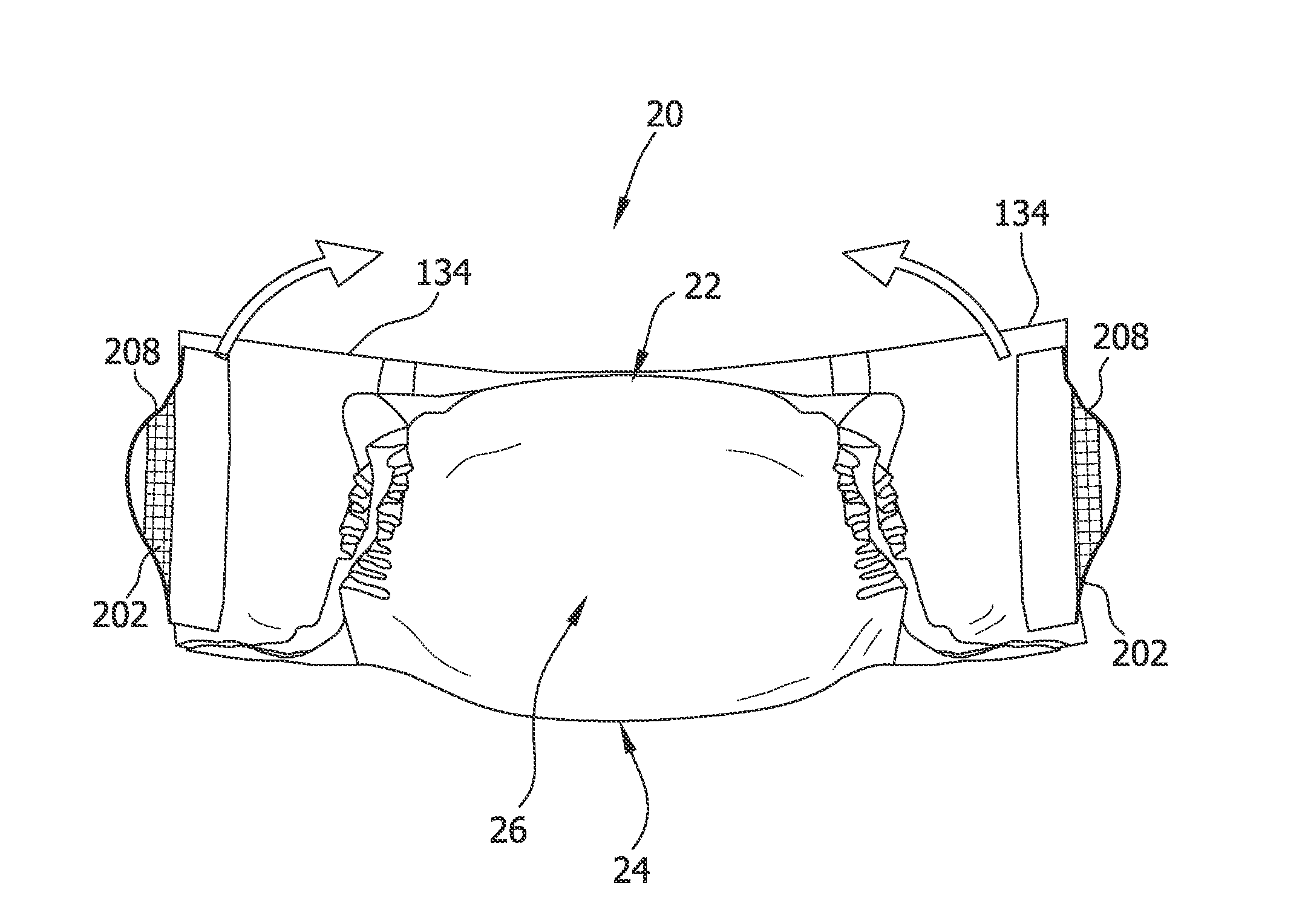
Leave a Reply